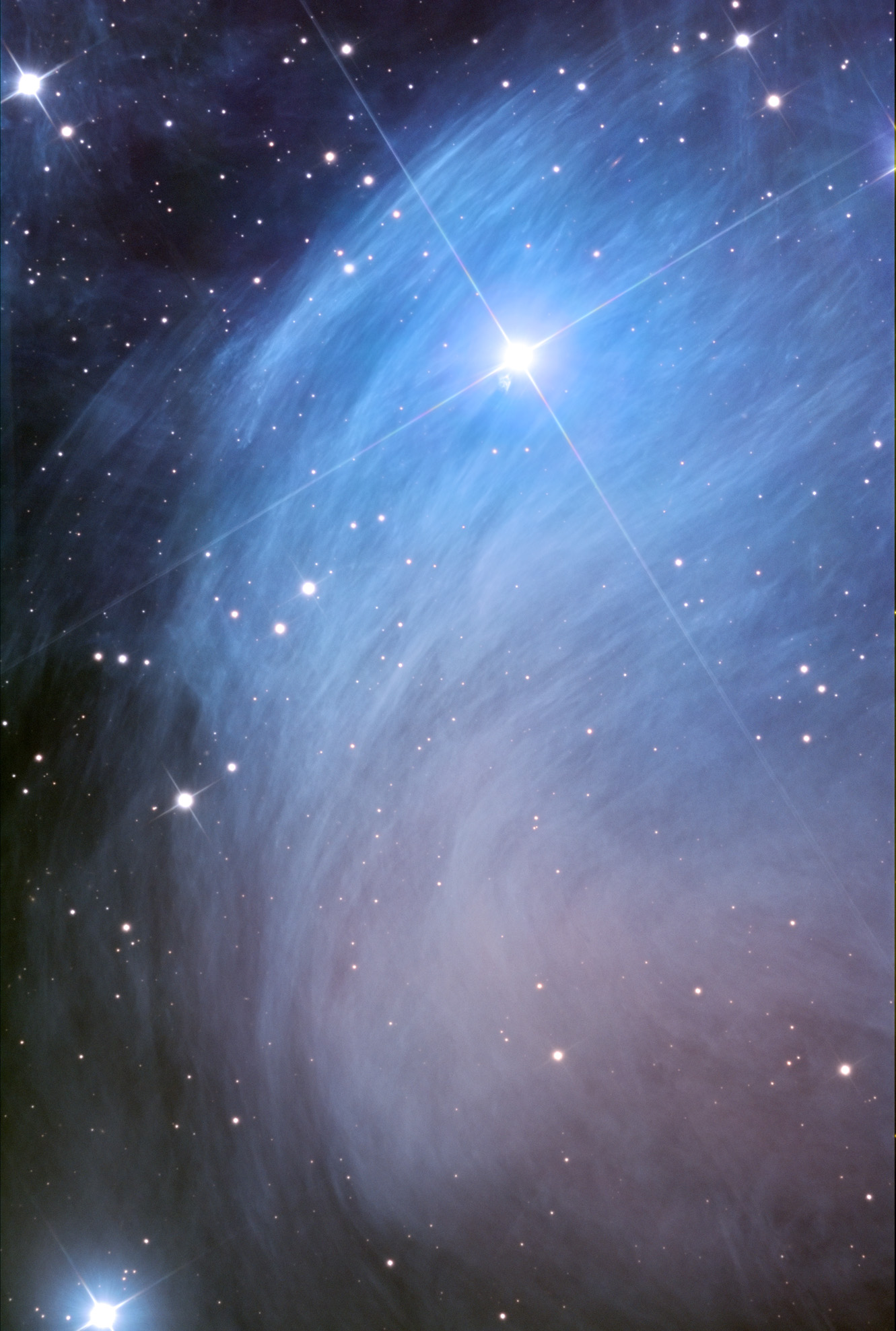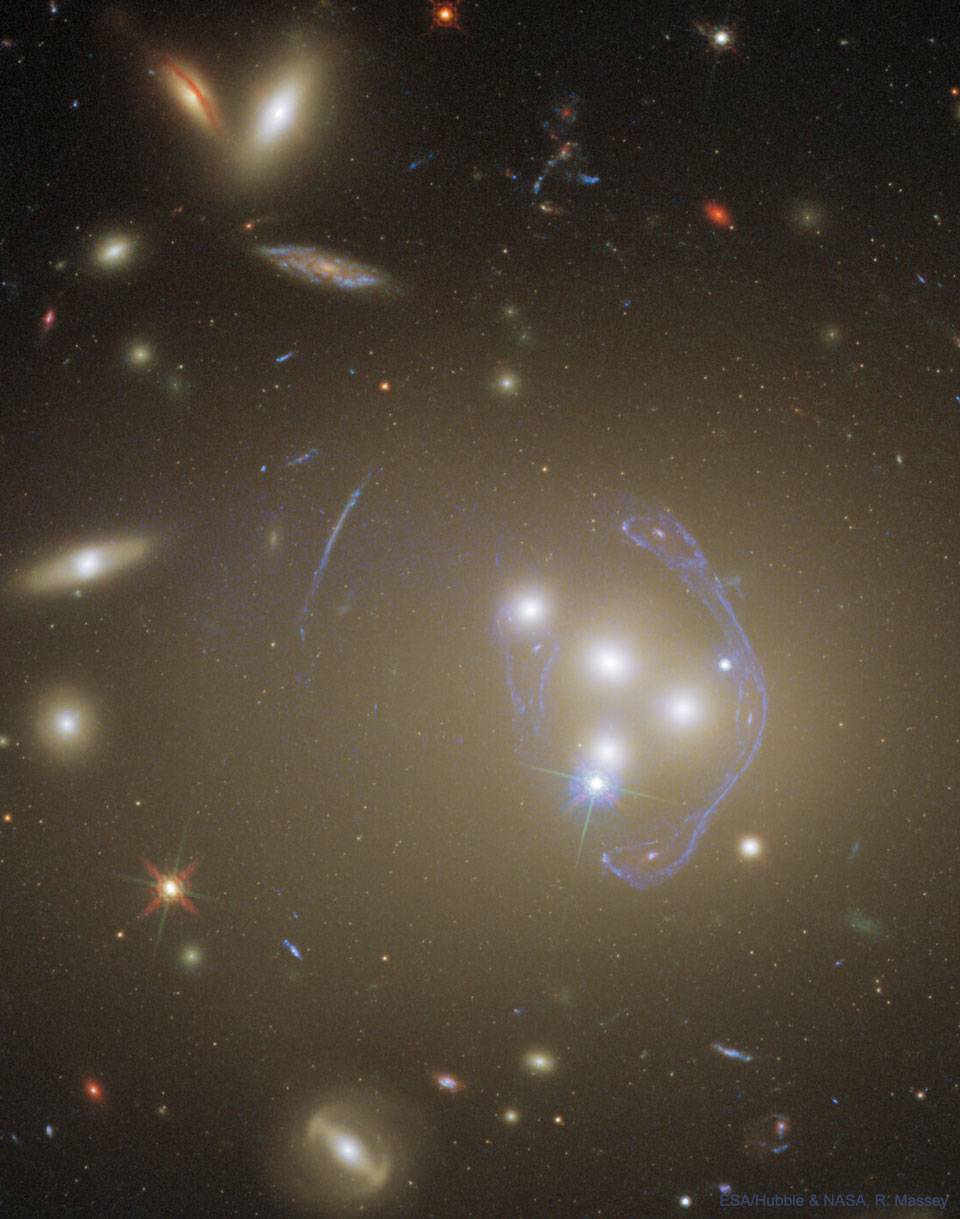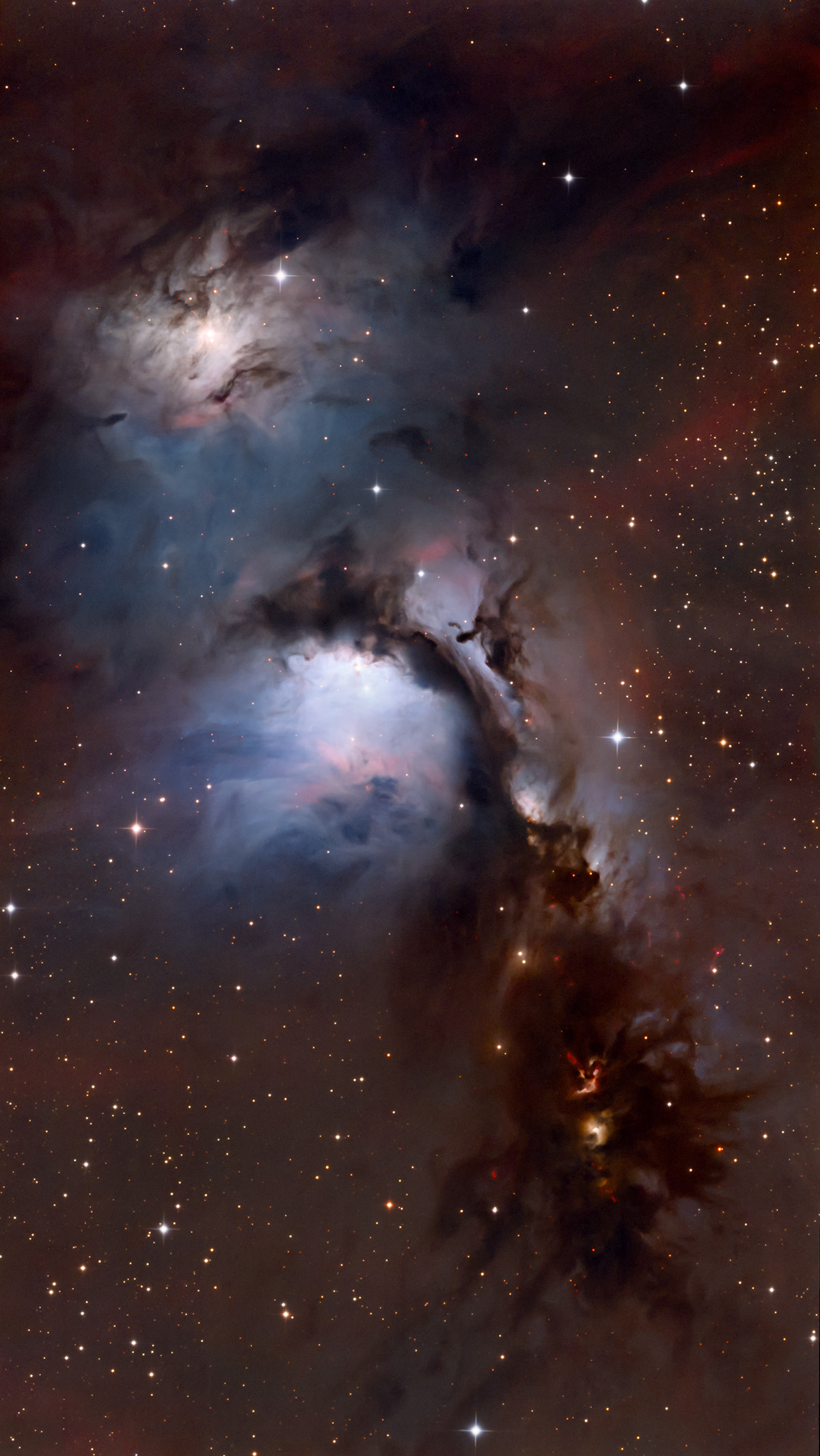Blog
The Merope Nebula (also known as Tempel’s Nebula and NGC 1435) is a diffuse reflection nebula in the Pleiades star cluster, surrounding the 4th magnitude star Merope. It was discovered on October 19, 1859 by the German astronomer Wilhelm Tempel. The discovery was made using a 10.5cm refractor. John Herschelincluded it as 768 in his General Catalogue of Nebulae and Clusters of Stars but never observed it himself.[4]
The Merope Nebula has an apparent magnitude starting at 13 and quickly dimming by a factor of about 15,[5]making most of the nebula dimmer than magnitude 16. It is illuminated entirely by the star Merope, which is embedded in the nebula. It contains a bright knot, IC 349, about half an arcminute wide near Merope, which was discovered by Edward Emerson Barnard in November 1890. It is naturally very bright but is almost hidden in the radiance of Merope. It appears blue in photographs because of the fine carbon dust spread throughout the cloud. Though it was once thought the Pleiades formed from this and surrounding nebulae, it is now known that the Pleiades nebulosity is caused by a chance encounter with the cloud.

John Cipollina (August 24, 1943 – May 29, 1989) was a guitarist best known for his role as a founder and the lead guitarist of the prominent San Francisco rock band Quicksilver Messenger Service. After leaving Quicksilver he formed the band Copperhead, was a member of the San Francisco All Stars and later played with numerous other bands.
John and his twin sister Manuela were born in Berkeley, California on August 24, 1943. Cipollina attended Tamalpais High School, in Mill Valley, California (as did his brother, Mario, born 1954) and sister, Antonia (born 1952). Their father, Gino, was of italian ancestry (Genovese and Piemontese origins). He was a realtor, and their mother, Evelyn, and godfather José Iturbi, were concert pianists.
John showed great promise as a classical pianist in his youth, but his father gave him a guitar when he was 12 and this quickly became his primary instrument. Cipollina died on 29 May 1989 at the age of 45 after a career in music that spanned twenty five years. His cause of death was alpha-1 antitrypsin deficiency, which he suffered from most of his life, and which is exacerbated by smoking.
more...Oteil Burbridge is an American multi-instrumentalist, specializing on the bass guitar, trained in playing jazz and classical music from an early age. He has achieved fame primarily on bass guitar during the resurgence of the Allman Brothers Band from 1997 through 2014, and as a founding member of the band Dead & Company. Burbridge was also a founding member of The Aquarium Rescue Unit and Tedeschi Trucks Band, with whom his brother Kofi Burbridge was the keyboardist and flautist. He has worked with other musicians including Bruce Hampton, Trey Anastasio, Page McConnell, Bill Kreutzmann and Derek Trucks.
Burbridge has been recognized for his ability to incorporate scat-singing into his improvised bass solos. Burbridge endorses Fodera, Modulus, Sukop and Dunlop guitars and effects.
more...Henry Franklin “Buster“ Smith (August 24, 1904 – August 10, 1991), also known as Professor Smith, was an American jazz alto saxophonist and mentor to Charlie Parker. Smith was instrumental in instituting the Texas Sax Sound with Count Basie and Lester Young in the 1930s.
Smith played saxophone for a number of prominent band leaders including Duke Ellington and Earl Hines as well as vocalist Ella Fitzgerald. He recorded his only album as leader in 1959 and despite intending to record a follow-up, he was injured in an accident and nothing else was released.
Smith was born and raised in Alsdorf, Texas, a small township near Telico in the outskirts of Dallas, where he attended school as a child. Smith earned the name “Buster” from his parents as a baby, as he was born as an overweight child. Buster was the third of five boys and had no sisters, though both of his older brothers died in childhood of measles.
more...Arthur William “Big Boy” Crudup (August 24, 1905 – March 28, 1974) was an American Delta blues singer, songwriter and guitarist. He is best known, outside blues circles, for his songs “That’s All Right” (1946), “My Baby Left Me” and “So Glad You’re Mine”, later recorded by Elvis Presleyand other artists.
Crudup was born in Union Grove, Forest, Mississippi, to a family of migrant workers traveling through the South and Midwest. The family returned to Mississippi in 1926, where he sang gospel music. He had lessons with a local bluesman, whose name was Papa Harvey, and later he was able to play in dance halls and cafes around Forest. Around 1940 he went to Chicago.
He began his career as a blues singer around Clarksdale, Mississippi. As a member of the Harmonizing Four, he visited Chicago in 1939. He stayed in Chicago to work as a solo musician but barely made a living as a street singer. The record producer Lester Melrose allegedly found him while Crudup was living in a packing crate, introduced him to Hudson Whittaker, better known as Tampa Red, and signed him to a recording contract with RCA Victor‘s Bluebird label.
more...Toward the right of the featured Hubble image of the massive galaxy cluster Abell 3827 is what appears to be a most unusual galaxy — curved and with three centers. A detailed analysis, however, finds that these are three images of the same background galaxy — and that there are at least four more images. Light we see from the single background blue galaxy takes multiple paths through the complex gravity of the cluster, just like a single distant light can take multiple paths through the stem of a wine glass. Studying how clusters like Abell 3827 and their component galaxies deflect distant light gives information about how mass and dark matter are distributed. Abell 3827 is so distant, having a redshift of 0.1, that the light we see from it left about 1.3 billion years ago — before dinosaurs roamed the Earth. Therefore, the cluster’s central galaxies have now surely all coalesced — in a feast of galactic cannibalism — into one huge galaxy near the cluster’s center.

Keith John Moon (23 August 1946 – 7 September 1978) was an English drummer for the rock band the Who. He was noted for his unique style and his eccentric, often self-destructive behaviour and drug addiction.
Moon grew up in Alperton, a suburb of Wembley, in Middlesex, and took up the drums during the early 1960s. After playing with a local band, the Beachcombers, he joined the Who in 1964 before they recorded their first single. Moon was recognised for his drumming style, which emphasised tom-toms, cymbal crashes, and drum fills. Throughout Moon’s tenure with the Who his drum kit steadily grew in size, and (along with Ginger Baker) he has been credited as one of the earliest rock drummers to regularly employ double bass drums in his setup. Moon occasionally collaborated with other musicians and later appeared in films, but considered playing in the Who his primary occupation, and remained a member of the band until his death. In addition to his talent as a drummer, Moon developed a reputation for smashing his kit on stage and destroying hotel rooms on tour. He was fascinated by blowing up toilets with cherry bombs or dynamite, and by destroying television sets. Moon enjoyed touring and socialising, and became bored and restless when the Who were inactive. His 21st birthday party in Flint, Michigan, has been cited as a notorious example of decadent behaviour by rock groups.
Moon suffered a number of setbacks during the 1970s, most notably the accidental death of chauffeur Neil Boland and the breakdown of his marriage. He became addicted to alcohol, particularly brandy and champagne, and acquired a reputation for decadence and dark humour; his nickname was “Moon the Loon”. After moving to Los Angeles with personal assistant Peter “Dougal” Butler during the mid-1970s, Moon recorded his only solo album, the poorly received Two Sides of the Moon. While touring with the Who, on several occasions he passed out on stage and was hospitalised. By the time of their final tour with him in 1976, and particularly during production of The Kids Are Alright and Who Are You, the drummer’s deterioration was evident. Moon moved back to London in 1978, dying in September of that year from an overdose of Heminevrin, a drug intended to treat or prevent symptoms of alcohol withdrawal.
Moon’s drumming continues to be praised by critics and musicians. He was posthumously inducted into the Modern Drummer Hall of Fame in 1982, becoming the second rock drummer to be chosen, and in 2011, Moon was voted the second-greatest drummer in history by a Rolling Stone readers’ pol. On 6 September 1978, Moon and Walter-Lax were guests of Paul and Linda McCartney at a preview of a film, The Buddy Holly Story. After dining with the McCartneys at Peppermint Park in Covent Garden, Moon and Walter-Lax returned to their flat. He watched a film (The Abominable Dr. Phibes), and asked Walter-Lax to cook him steak and eggs. When she objected, Moon replied, “If you don’t like it, you can fuck off!” These were his last words. Moon then took 32 clomethiazole tablets. When Walter-Lax checked on him the following afternoon, she discovered he was dead.
more...Terje Rypdal (born 23 August 1947) is a Norwegian guitarist and composer. He has been an important member in the Norwegian jazz community, and has also given show concerts with guitarists Ronni Le Tekrø and Mads Eriksen as “N3”.
Rypdal was born in Oslo, Norway, the son of a composer and orchestra leader. He studied classical piano and trumpet as a child, and then taught himself to play guitar as he entered his teens. Starting out as a Hank Marvin-influenced rock guitarist with The Vanguards, Rypdal turned towards jazz in 1968 and joined Jan Garbarek‘s group and later George Russell‘s sextet and orchestra. An important step towards international attention was his participation in the free jazz festival in Baden-Baden, Germany, in 1969, where he was part of a band led by Lester Bowie. During his musical studies at Oslo university and conservatory, he led the orchestra of the Norwegian version of the musical Hair. He has often been recorded on the ECM record label, both jazz-oriented material and classical compositions (some of which do not feature Rypdal’s guitar).
more...Gilbert Lloyd “Gil” Coggins (August 23, 1924 – February 15, 2004) was an American jazz pianist.
Coggins was born to parents of West Indian heritage. His mother was a pianist and had her son start on piano from an early age. He attended school in New York City and Barbados. In Harlem, New York City, he attended The High School of Music & Art.
In 1946, Coggins met Miles Davis while stationed at Jefferson Barracks in Missouri. After his discharge he began playing piano professionally, working with Davis on several of his Blue Note and Prestige releases. Coggins also recorded with John Coltrane, Sonny Rollins, Lester Young, Art Blakey‘s Jazz Messengers, Ray Draper, and Jackie McLean.
Coggins gave up playing jazz professionally in 1954 and took up a career in real estate, playing music only occasionally. He did not record as a leader until 1990, when Interplay Records released Gil’s Mood. He continued performing through the 1990s and 2000s until 2004, when he died from complications sustained in a car crash eight months earlier in Forest Hills, New York. Better Late Than Never, his second album recorded as a leader, was released posthumously.
more...Wynona Carr (August 23, 1923 – May 11, 1976) was an American gospel, R&B and rock and roll singer-songwriter, who recorded as Sister Wynona Carr when performing gospel material.
Wynona Merceris Carr was born in Cleveland, Ohio, where she started out as a gospel singer, forming her own five-piece group The Carr Singers around 1945 and touring the Cleveland/Detroit area. Being tipped by the Pilgrim Travelers, who shared a bill with Carr in the late 1940s, Art Rupesigned her to his Specialty label, giving Carr her new stage name “Sister” Wynona Carr (modelled after pioneering gospel singer Sister Rosetta Tharpe) and cutting some twenty sides with her from 1949 to 1954, including a couple of duets with Specialty’s biggest gospel star at the time, Brother Joe May.
more...Messier 78 or M78, also known as NGC 2068, is a reflection nebula in the constellation Orion. It was discovered by Pierre Méchain in 1780 and included by Charles Messier in his catalog of comet-like objects that same year.
M78 is the brightest diffuse reflection nebula of a group of nebulae that includes NGC 2064, NGC 2067 and NGC 2071. This group belongs to the Orion B molecular cloud complex and is about 1,350 light-years distant from Earth. M78 is easily found in small telescopes as a hazy patch and involves two stars of 10th and 11th magnitude. These two B-type stars, HD 38563 A and HD 38563 B, are responsible for making the cloud of dust in M78 visible by reflecting their light.
The M78 cloud contains a cluster of stars that is visible in the infrared. Due to gravity, the molecular gas in the nebula has fragmented into a hierarchy of clumps, the denser cores of which about to form stars with masses of up to 5 M☉. About 45 variable stars of the T Tauri type, young stars still in the process of formation, are members as well. Similarly, 17 Herbig–Haro objects are known in M78.

Donna Jean Thatcher Godchaux-MacKay (born August 22, 1947) is an American singer, best known for having been a member of the Grateful Dead from 1972 until 1979.
Donna Jean Thatcher was born in Florence, Alabama. Prior to 1970, she had worked as a session singer in Muscle Shoals, Alabama, eventually singing with a group called Southern Comfort and appearing as a backup singer on at least two #1 hit songs: “When a Man Loves a Woman” by Percy Sledge in 1966 and “Suspicious Minds” by Elvis Presley in 1969. Her vocals were featured on other classic recordings by Boz Scaggs and Duane Allman, Cher, Joe Tex, Neil Diamond and many others. She then moved to California and met future fellow Grateful Dead member Keith Godchaux, whom she married in 1970.
more...Delmar Allen “Dale” Hawkins (August 22, 1936 – February 13, 2010) was a pioneer American rock singer, songwriter, and rhythm guitarist who was often called the architect of swamp rock boogie. Ronnie Hawkins is his cousin.
He began recording in 1956. In 1957, Hawkins was playing at Shreveport, Louisiana clubs, and although his music was influenced by the new rock and roll style of Elvis Presley and the guitar sounds of Scotty Moore, Hawkins blended that with the uniquely heavy blues sound of black Louisiana artists for his recording of his swamp-rock classic, “Susie Q.” Fellow Louisiana guitarist and future Rock and Roll Hall of Famer James Burton provided the signature riff and solo.
more...Malachi Favors (August 22, 1927 – January 30, 2004) was an American jazz bassist who played with the Art Ensemble of Chicago.
“Favors’s tendency to dissemble about his age was a well-known source of mirth to fellow musicians of his generation”. Most reference works give his year of birth of 1937, but, following his death, his daughter stated that it was 1927.
Favors primarily played the double bass, but also played the electric bass guitar, banjo, zither, gong, and other instruments. He began playing double bass at the age of 15 and began performing professionally upon graduating from high school. Early performances included work with Dizzy Gillespie and Freddie Hubbard. By 1965, he was a founder of the Association for the Advancement of Creative Musicians and a member of Muhal Richard Abrams‘ Experimental Band.
more...Sonny Thompson (probably August 23, 1916 – August 11, 1989), born Alfonso Thompson or Hezzie Tompson, was an American R&B bandleader and pianist, popular in the 1940s and 1950s.
There is some uncertainty over Thompson’s origins, as well as his birth name. Researchers Bob Eagle and Eric LeBlanc indicate that he was born in 1916 in Wilkinson County, Mississippi, but other sources state that he was born in 1923, either in Mississippi or in Chicago.
He began recording in 1946, and in 1948 achieved two #1 R&B chart hits on the Miracle label – “Long Gone (Parts I and II)” and “Late Freight“, both featuring saxophonist Eddie Chamblee. The follow-ups “Blue Dreams” and “Still Gone” also reached the R&B chart. By 1952 he had moved on to King Records, where he worked in A&R and as a session musician and arranger. At King, he had further R&B Top 10 successes with the singer Lula Reed, the biggest hit being “I’ll Drown in My Tears“. Thompson married Reed sometime in the early 1950s. He continued to work as a session musician, and to perform with Reed into the early 1960s. He also had success as a songwriter, often co-writing with blues guitarist, Freddie King.
Thompson died in 1989 in Chicago.
more...More Posts
- Lester Young Day
- World Music with Beginish
- Daily Roots with Ijahman Levi
- The Cosmos with M100
- Branford Marsalis Day
- Leon Redbone Day
- World Music with Gjallarhorn
- Daily Roots with Horace Andy
- The Cosmos with NGC 6820/3
- Pat Martino Day
- Wayne Shorter Day
- World Music with Songhoy Blues
- Daily Roots with Johnny Osborne
- The Cosmos with NGC 4100
- Jim Capaldi Day
- Arthur “Big Boy” Crudup Day
- World Music with Cayetano Moreno Castro
- Daily Roots with Cornell Campbell
- The Cosmos with NGC 6503
- Keith Moon Day